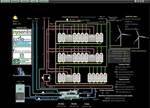PS Foam Labels Keep the Chill In
Technology to target canned, craft beer and contract labeling companies to start.
Commodore Plastics, Bloomfield, N.Y., is offering a new type of coextruded PS foam shrink label that insulates aluminum, glass, and PET beverage containers to keep liquids colder longer. The labeling system, called Labec, is produced by Commodore under a licensing agreement with foam giant Sekisui of Japan. Commodore produces the sheet on a 2.5/3.5-in. tandem extruder setup equipped with a 2-in. coextruder at an output rate of 160 lb/hr, states Brad Braddon, Commodore president. Process conditions are modified to yield a foamed sheet with a high level of closed cells needed to provide the required insulation properties, adds Gary Duncan, who is consulting with Commodore on the project and acting as a sales agent. The sheet is produced in thicknesses from 5 to 10 mils.
Aluminum cans figure to be a main target, since as conductors they tend to heat up quickly, remarks Duncan. Tests conducted by Commodore demonstrated that Labec labels keep beverages colder for an average of 15 to 20 min longer than cans alone, based on a beverage-temperature gain without the label of 20-30° F in 1 hr.
The foam labels can be printed, hot stamped, metalized, and embossed, among other decorating options, and can be easily added to existing filling lines, states Duncan.
Commodore is targeting initially smaller craft beer makers and contract labeling companies.
Foamed labels are commonly used on microwaveable food packaging. They were tried years ago on glass bottles mainly to prevent injury in the event of breakage, but the technology stalled as bottles started to transition from glass to plastic.
Related Content
-
Get Color Changes Right In Extrusion Blow Molding
Follow these best practices to minimize loss of time, material and labor during color changes in molding containers from bottles to jerrycans. The authors explore what this means for each step of the process, from raw-material infeed to handling and reprocessing tails and trim.
-
Thin, High-Performance Nylon/PE Barrier Film for Thermoformed Packaging
Südpack’s Multifol Extreme film is well suited for greasy, protein-rich and frozen foods
-
US Merchants Makes its Mark in Injection Molding
In less than a decade in injection molding, US Merchants has acquired hundreds of machines spread across facilities in California, Texas, Virginia and Arizona, with even more growth coming.




